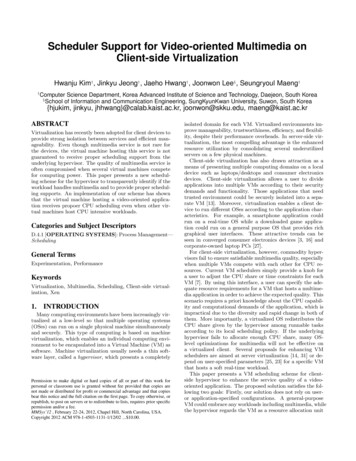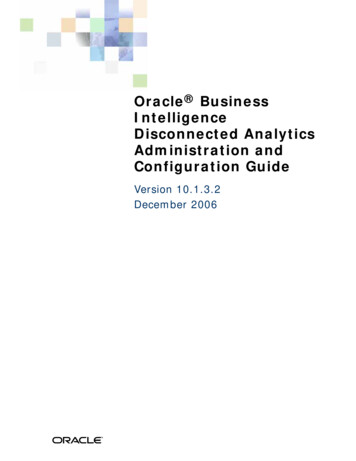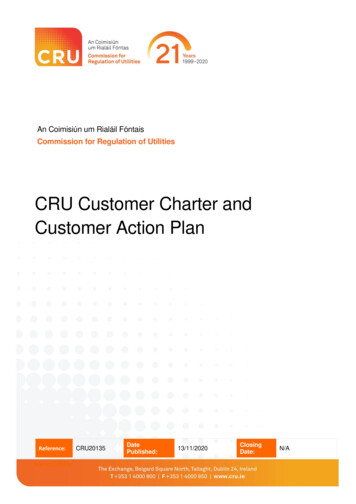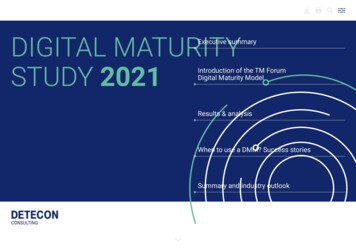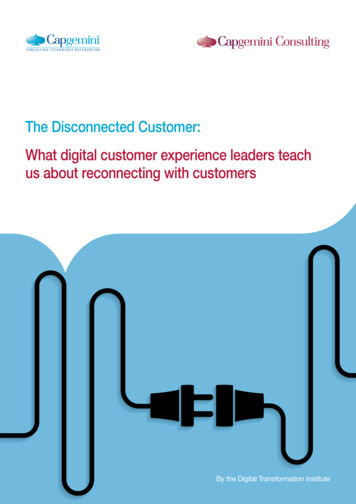
Transcription
The Disconnected Customer:What digital customer experience leaders teachus about reconnecting with customersBy the Digital Transformation Institute1
The rewards of a superior digitalcustomer experienceNot many companies successfully deliver a great digital customer experience and enjoy the rewards. Thereare, however, some notable exceptions: 17 million customers use Starbucks’ mobile app1. Not only does it allow consumers to place and pay foran order before reaching a store and pick it up without waiting in line, it’s also a platform where memberscan redeem loyalty rewards. Within eight months of its release in 2015, it was processing over sevenmillion mobile orders a month. Nordstrom, the American luxury retailer, offers customers a host of digital services: mobile checkout, theability to text salespeople, and a personalized digital clothing service. It reported e-commerce sales ofover 2.5 billion, representing nearly a quarter of its full-price sales for FY 20162.What makes these leaders and other firms like them stand out in terms of the digital customer experience?What kind of gains can organizations expect to see when they prioritize the digital customer experienceand execute on it?81%of consumersare willing topay for a betterexperienceTo find answers to these and other questions, we conducted a large research exercise, reaching out to 450executives and 3,300 consumers in sectors that included Utilities, Consumer Products, Retail Banking,Retail and Internet-based services3. More details on our approach and research methodology are includedat the end of this report.Consumers are ready to reward better experiences withincreased spendingOur research found that over 80% of consumers are willing to pay more for a better experience (see Figure1). This holds true across sectors and countries, with around 1 in 10 consumers (9%) willing to increasetheir spending by more than half.Figure 1: Consumers are willing to spend more for a better experiencePercentage of consumers willing to spend morefor a better experience – by sectorOverall81%Internet-Based Services87%Retail86%Consumer ProductsRetail BankingUtilities81%79%73%N 3372 consumers. Percentages may not total 100 due to rounding.Source: Capgemini Digital Transformation Institute analysis; Capgemini digital customer experience executive survey February-March 2017, andconsumer survey March 20172
Figure 1: Consumers are willing to spend more for a better experience (cont.)morePercentage of consumers willing to spend morefor a better experience – by %GermanyPercentage of consumers who are willing to increase their spend for a betterexperience – by spend dServicesIncrease up to ail BankingIncrease by 16-50%UtilitiesIncrease by more than 50%11%Retail18%14%9%OverallUnwilling to increase spendingN 3372 consumers.not total 100 due to rounding.Percentagesmay not totalPercentagesto 100 due nInstituteanalysis;Capgeminidigital customersurveyFebruary-March2017, and nInstituteanalysis;Capgeminidigital experiencecustomer executiveexperienceexecutivesurvey February-March2017,and March 2017consumer survey March 20173
Over 80Number of DCXpractices weanalyzed in ourDCX IndexDigital customer experience is linked with a firm’s key performanceindicatorsTo investigate the relationship between the organization’s digital customer experience and the benefits thatorganizations can generate, we developed a Digital Customer Experience (DCX) Index. This essentially scoresthe maturity of an organization’s digital customer experience. The more DCX practices an organizationadopts, the higher the index (see the “DCX Index”).DCX IndexThe DCX Index measures the range and extent of an organization’s digital customer experience practices. In our survey, weasked company executives about the adoption of more than 80 practices that spanned the customer journey. For example: How closely do business operations align with an organization’s customer experience?To what extent do your customers experience a seamless purchase process?Does your company provide real time, personalized offers and communication on digital channels?Does your company provide loyalty and referral programs on digital channels?What amount of customer service is provided via digital channels as a share of total service volume?The greater the adoption of best practices, the higher the organization’s DCX Index. In addition, we: Weighted practices based on their implementation difficulty, awarding more points to companies for mastering practicesthat are harder to implement. Took into account consumers’ views on how well companies were adhering to these practices, with a composite of executiveand consumer scores forming the company’s index score.Figure: Calculation of DCX IndexExecutives’scores on theadoption of DCXpractices by thecompanyConsumers’scores onexperiencederived fromthe companyExecutives were askedquestions such as:Consumers were askedquestions such as:How closely arebusiness operationsaligned with thecustomer experience?To what extent do youagree that:Does your companyprovide loyalty andreferral programs ondigital channels?4The company listens toyour feedback and actson itThe company providesa better experience thanmost of its competitorsDCX Index ofthe companyThe DCX Index is anumber between 0 and100 and is calculatedas an average of theexecutives’ andconsumers’ scores fora company
The DCX Index is strongly related to the Net Promoter ScoreSM (NPS )4 of a company (see Figure 2). Wealso found that the top DCX Index companies outperformed the lowest-scoring ones by a factor of 2.7 interms of growth in stock. The top ten companies with the highest DCX Index in our sample saw their shareprices increase by 16% on average over the last five years. However, the bottom ten players increased theirshare prices by only about 6% on average.Figure 2: DCX Index is strongly related with NPS and growth in stock pricesCorrelation between Net Promoter Score (NPS ) and the DCX Index16%vs.6%Correlation Coefficient 0.73Net PromoterScore (NPS )Growth in stockprices of top tencompanies in ourDCX Index vs.bottom ten overthe last five yearsDCX IndexN 122 companies. Each dot represents the DCX Index and NPS of a companyGrowth in stock prices of DCX Index leaders and laggards(2011 price 100)16710011910010220112012132208CAGR 15.7%CAGR 6%1831371311342014201520161232013Average stock price of top 10 companies on DCX IndexAverage stock price of bottom 10 companies on DCX IndexSource: Capgemini Digital Transformation Institute analysis4.Net Promoter, NPS , and the NPS -related emoticons are registered service marks, and Net Promoter Score and Net Promoter System areservice marks, of Bain & Company, Inc., Satmetrix Systems, Inc. and Fred Reichheld5
The digital customer experience drives customer satisfactionand spendingOur research shows a clear link between a better digital customer experience and value return (see Figure 3): A 1 point increase in the DCX Index corresponds to a nearly 0.6 percentage point increase in customerwillingness to spend more. Put another way, customers would be willing to spend 0.6% extra on averageif a company improved its DCX Index by 1 point5. A 1 point increase in DCX Index correlates to a 4.7 point increase in a company’s NPS on average (alsosee “NPS leadership magnifies the advantage from an improved customer experience”).Figure 3: DCX Index is positively linked with customer satisfaction and willingness to spendRelationship between increases in DCX Indexand customers' willingness to spend53.8644.7points1 point increasein our DCXIndex leads toa 4.7 pointsincrease in NPS3.22Extra amount thatcustomers would bewilling to spend(percentage points)32.571.93211.290.64012345Increase in DCX Index (points)6Relationship between increases in DCX Indexand increase in NPS 3028.123.425Increase in NetPromoter Score (points)18.72014.0159.410504.712345Increase in DCX Index (points)6Source: Capgemini Digital Transformation Institute analysis; Capgemini digital customer experience executive survey February–March 2017, andconsumer survey March 20176
Companies that closely tie business operations with customerexperience enjoy greater benefitsOur analysis reveals that organizations that tightly link their business operations with the customer experiencereap greater rewards in terms of NPS and positive customer perceptions (see Figure 4). Organizations wesurveyed fall under one of the following broad categories: Companies with business operations closely linked with NPS (6%): These organizations monitortheir NPS or customer experience performance on a daily basis and share the information with managers.This creates a better alignment between business operations and NPS performance. Companies with business operations loosely linked with NPS (61%): At these firms, NPS orcustomer experience is monitored on a regular basis. However, business operations are revisited onlyat fixed intervals, such as quarterly, half-yearly, or even less frequently. Companies with business operations not linked with NPS (33%): These companies do not trackNPS or customer experience at regular intervals and these have no bearing on operations.Figure 4: Organizations aligning operations with customer experience enjoy greater rewardsOrganizations with businessoperations linked with NPS observebetter NPS performance55%14pointsNPS advantageof companieswith businessoperationsclosely linkedwith NPSConsumers more favorably rankorganizations with businessoperations linked with NPS 46% 46%1449%41% 42%127260Advantage in NPS over companieswith no linkagebetween businessoperations and NPS Average increasein NPS in the last3 yearsConsumers whobelieve that thecompany providesbetter experiencethan most of itscompetitorsConsumers whobelieve that thecompany listensto their feedbackand acts on itCompanies with business operations closely linked with NPS Companies with business operations loosely linked with NPS Companies with business operations not linked with NPS N 125 companies and their 3372 consumersSource: Capgemini Digital Transformation Institute analysis; Capgemini digital customer experience executive survey February-March 2017, andconsumer survey March 2017In the section that follows, we examine whether or not organizations are prioritizing their digital customerexperience and, crucially, what consumers think of their efforts. We also look at how organizations canseize the rewards of a positive digital customer experience.7
NPS leadership magnifies the advantage from an improved customer experienceWe have found a positive link between an organization’s DCX Index and its NPS . To understand the potential value of thatlink, we compared a group of high NPS performers to those with less stellar results (see “Key characteristics of NPS leaders vs. laggards” below). We found that leaders gain a 60% advantage over laggards in terms of increased customerwillingness to spend. The NPS leaders stand to gain nearly 35 billion, or about 2.5% of their total annual revenue, in additional sales revenueby delivering an enhanced experience. NPS laggards would only gain an additional 1.2 billion or 1.5% of their total annual revenue.Extra spendingfrom consumersupon receiving abetter customerexperienceTotal added revenuefrom increasedconsumer spendingShare of totalannual revenueAverage addedrevenue percompanyFor 15 lowcompanies 1.2 billion1.5% 80 million 35.3 billion2.4% 2.35 billionNPS For 15 high NPS companiesKey characteristics of NPS leaders vs. laggardsKey CharacteristicsTop 15 High NPS organizationsBottom 15 Low NPS organizationsAverage NPS 9-66Average increase in NPS in thelast three years (according toconsumers)12 points2 pointsAverage annual revenue 146 billion 18 billionBusiness segmentMostly large retail and consumerproducts firmsMostly small and mid-size utilitiesSource: Capgemini Digital Transformation Institute analysis8
Organizations and consumers are milesapart on the customer experience78%Percentageof utilitiesbelieve they arecustomer-centric,but only 7% ofconsumers agreeCompanies and their consumers do not see eye-to-eye on the customer experience. Our research found:1. A major gap between consumers and companies on customer centricity2. A disconnect on NPS in many sectors3. A clear signal from consumers that they feel their voice is not heard and their loyalty is not rewarded.A major gap between consumers and companies on customer centricity. We found that whilethree-quarters (75%) of organizations believe themselves to be customer-centric, only 30% of consumersbelieve this to be the case (see Figure 5).Utilities are particularly out of sync. We found that 79% of utilities believe they are customer-centric, butonly 7% of consumers agree. Regionally, only companies in Asia-Pacific can claim to be in tune with theirconsumers.Figure 5: Consumer and company perception of customer centricity75%56%Company Perceptionof Customer CentricityHigh19%Companies that considerthemselves as highlycustomer-centric whereastheir consumers don’t agreeCompanies and theirconsumers agree that thecompanies are highlycustomer-centricConsumer Perceptionof Customer CentricityLow15%High30%11%Companies and theirconsumers agree that thecompanies are low oncustomer centricityCompanies that considerthemselves as low oncustomer centricitywhereas their consumersperceive them as highLowN 125 companies and their 3372 consumers. The vertical axis represents the average rating by company executives on whether they believe theircompany is customer centric. The horizontal axis represents the average rating of the consumers of the same company on the customer centricity ofthe company. Both questions had a scale of 1-7. Consumers or executives rating a company 4.5 or more were considered to be in favor of highcustomer centricity.9
Key characteristics of customer centricity leaders vs. laggardsKey CharacteristicsTop 15 customer-centric Bottom 15 customer-centricorganizationsorganizations 5-64Average increase in NPS in thelast three years (according toconsumers)13 points2 pointsAverage reduction in spendingby consumers for a negativecustomer experience41%53%Business segmentMostly large retail and retailbanking firmsMostly small and mid-sizeutilitiesAverage NPS Source: Capgemini Digital Transformation Institute analysisFigure 5 (continued): Consumer and company perception of customer centricity – by industryConsumer and company perception of customer centricity –By esConsumer ProductsRetailRetail BankingInternet-BasedServicesOverallPercentage of companies whose consumers believe they are customer-centricPercentage of companies who perceive themselves to be customer-centricN 125 companies and their 3372 consumers.Source: Capgemini Digital Transformation Institute analysis; Capgemini digital customer experience executive survey February-March 2017, andconsumer survey March 201710
Figure 5 (continued): Consumer and company perception of customer centricity – by geographyConsumer and company perception of customer centricity By ceUSGermanyAsia-PacificOverallPercentage of companies whose consumers believe companies are customer-centricPercentage of companies who perceive themselves to be customer-centricAPAC countriesincludeandAustralia,IndiaN c countries include: Australia, China and India.Source: Capgemini Digital Transformation Institute analysis; Capgemini digital customer experience executive survey February-March 2017, andconsumer survey March 201780%Percentage ofconsumers whobelieve theirInternet-basedservices companyhas improved itsNPS by more than5 points in the lastthree yearsThe UK, France and the US are most out of sync with their consumers. We found that this disconnectruns deeper than just on customer centricity. Customers in these countries also rank companies lower onseveral important issues. For instance, only 34% of US consumers believe that companies reward themfor loyalty—the lowest across all surveyed countries. And only 26% of consumers in the UK believe thatcompanies understand their needs.A disconnect on NPS in most sectors.We can see a larger divide between consumers and companies when we analyze the NPS data in detail. Alarge majority of companies—more than 8 out of 10 on average across sectors—derive a negative NPS fromtheir consumers. As Figure 6 shows, there are more detractors among consumers than there are promoters.For many companies, this unwelcome news will be tempered if they are committed to improving their scoreover time as part of a calculated and determined approach. However, it is clear that many companies arenot making progress. In consumer goods, for example, a third of companies have actually seen their NPS decrease over the last three years—the highest among all sectors6.11
Figure 6: Over 80% of firms have a negative NPS and nearly 20% have seen their NPS decrease in the last three RetailBanking20%12%Internet ConsumerBasedProductsServicesOverallPercentage of companies with negative NPSPercentage of companies whose NPS reduced in the last three years according to consumersN 125 companies.Source: Capgemini Digital Transformation Institute analysis; Capgemini digital customer experience executive survey February-March 2017, andconsumer survey March 201733%Consumerproducts firmsthat saw theirNPS reduceover the lastthree yearsaccording toconsumersMany Internet-based services firms are in touch with consumers on how their NPS has evolved. We foundthat 80% of consumers believe their Internet-based services company has improved its NPS by more thanfive points in the last three years. As Figure 7 shows, this is close to the perceptions of executives (76%).However, in traditional industries—such as consumer products and utilities—the gap between organizationsand consumers on this score is very pronounced. The concern is that firms may be under the incorrectimpression that they are improving their customer experience when their customers think differently. Figure 7: How consumersConsumerand companiesbelievetheir NPSincreasedand companyperceptionof NPSevolution over the last three Consumer ProductsRetailRetail BankingInternet-BasedServicesOverallPercentage of companies whose NPS according to its consumers increased by more than 5 points in last 3 yearsPercentage of companies whose NPS according to its executives improved by more than 5 points in 3 yearsN 125 companies and their 3372 consumers.Source: Capgemini Digital Transformation Institute analysis; Capgemini digital customer experience executive survey February–March 2017, andconsumer survey March 201712
Consumers feel their voice remains unheard and their loyalty unrewarded.Consumers do not want to be passive users—they want their voice heard and their loyalty rewarded. Yet,our research finds that many consumers are not receiving the attention they desire (see Figure 8). In addition,in most industries we surveyed, less than half of consumers believe their organization provides a bettercustomer experience than the competition.Consumer perception of companies on key customer considerationsFigure 8: Consumerperception of companies on key customer considerations59%38%34%30%32%45%43%46%48%47% 46% il ge of consumers who belive companies listen to their feedback and act on itPercentage of consumers who believe companies rewards them for loyaltyPercentage of consumers who believe companies provide better customer experience than competitionN 3372 consumers.Source: Capgemini Digital Transformation Institute analysis; Capgemini digital customer experience executive survey February–March 2017, andconsumer survey March 2017This disconnect can prove to be costly.Consumers can be fairly ruthless in their pursuit of the experience they want and vote with their wallets iftheir needs are not met. Our survey found that nearly one in five consumers stopped purchasing from acompany altogether when it failed to provide a positive experience (see Figure 9).Figure 9: How consumers vote with their wallet1 in 5consumersstoppedpurchasingfrom a companyafter a poorexperiencePercentage of consumers who stopped purchasing from thecompany altogether upon having a negative ailInternetBasedServices17%RetailBankingN 3372 consumers.Source: Capgemini Digital Transformation Institute analysis; Capgemini digital customer experience executive survey February-March 2017, andconsumer survey March 201713
Even a perfunctory analysis shows that organizations with an inferior experience could concede about 10%of wallet share to their competitors. Even if a firm has been providing a decent level of customer experience,failing to drive further improvements leaves about 14% of extra value on the table.Potential loss of wallet share to competitors annuallyAverage reduction in spending by consumersupon receiving poor customer experience(all consumers)39%Average reduction in spending by consumerswho rank companies serving them poorly oncustomer experience vis-à-vis competition46%7% points (46%-39%) due to poorer experiencecompared to competition 2% growth in personal consumption as pereconomic estimates 10% wallet share ceded to competitionannuallyPotential value left on the table by failing to provide a better customer experienceAverage expected increase in spending byconsumers for a better customer experience(all consumers)24%Average expected increase in spendingfor consumers who rank their companiesfavorably on customer experience vis-à-viscompetition36%12% points ( 36%-24%) owing to customer’spropensity to spend more for a better experience 2% owing to growth in personal consumptionas per economic estimates 14% extra value left on the table by failing toprovide a better customer experienceNote: In the U.S., personal consumption is expected to increase at 2.4% until 2024 while in Europe, private consumption is projected to average 1.6% in2017 and 1.5% in 20187Source: Capgemini Digital Transformation Institute analysis; Capgemini digital customer experience executive survey February–March 2017, andconsumer survey March 2017In the following section, we examine what companies can do to mend this great rift with consumers. Wetake a closer look at what sets customer experience leaders apart from their peers, and how organizationscan formulate a differentiated and coherent customer experience strategy.14
Digital customer experience bestpracticesThe key to a differentiated customer experience, and a higher DCX Index, is about mapping and connectingthe goals of the customer and the brand at key points in the relationship lifecycle, from when the customerbuilds awareness of the market offer to when they are willing to recommend the product (see Figure 10).When practices and processes are in place at critical stages of the lifecycle, a consumer will advance fromawareness and proceed, eventually, to advocacy.Figure 10: How company business goals and customer journeys come together throughout thecustomer life cycleAttract thecustomerSell to yaltyCustomerconsiders apurchaseCustomermakes apurchaseCustomerrecommendsthe productProduct or servicerequiresmaintenance34Marketing& Selling278Service& Support156CustomerconductsresearchCustomer buildsawareness ofmarket offeringsCustomerreceivesproduct or serviceCustomerexperiencesproduct or serviceInform thecustomerInfluence thecustomerFulfill theorderRetain thecustomerCustomer Moments of TruthCompany Business GoalsSource: Capgemini Digital Transformation Institute analysisWe wanted to understand what digital practices were critical to the lifecycle. We analyzed over 80 digitalpractices ingrained in our DCX Index, drawing out the top three practices that distinguish the leader groupand separate them from the laggards (see Figure 11). The good news is that these practices are notrevolutionary in nature – they have been around for a while and accessible to all organizations. Yet, only afew organizations have implemented them so far. For instance, in retail banking, 50% of DCX Index leadersfollow all top three best practices whereas only 7% of the rest of the companies do so. Similarly, more thanhalf of DCX Index leaders in the retail industry (53%) have adopted all the top practices while only about aquarter of the other firms (25%) in the sector have done so.15
Figure 11: Top three practices that distinguish DCX Index leaders, by sectorBest PracticesExampleRetailAbility to personalize products and servicesonline or on mobile2. Using customer data to predict changes inconsumer behaviour and tailor offerings3. Launching new IT initiatives to improvecustomer experience on digital channels1.As part of its omni-channel strategy, one of theworld’s largest DIY retailers and Capgemini clientdeveloped an app that includes information on over500,000 products. This provides a better mobileexperience and access to more services, includingin-store services. It also allowed the company tobuild a contextual view of the consumer and theirjourney, increasing both app traffic and revenue.Consumer Products1.2.3.Ability to personalize products and servicesonline or on mobileProviding loyalty points/incentives forcustomers to use digital channelsProviding users control over viewing, editingand removing their personal data Olay, Procter & Gamble’s skincare brand, recentlylaunched an artificial intelligence-powered mobileplatform that helps women better understandtheir skin and gives them a personalized regimenrecommending products that are right for theirskin type 8. Since its launch in late 2016, theplatform has already seen over a million visits. Nestlé ensures that its consumers are fullyinformed about the data it collects about themonline, how consumers can control that data andwho can access that data9. This puts consumersin charge of their data and allays any potentialconcerns consumers may have about datasecurity and privacy.Retail BankingRunning marketing campaigns to encourageuse of digital channels by customers2. Providing targeted offers and incentives onlyon digital channels3. Encouraging existing customers to refer newcustomers via digital channels1.A personal finance department of a large multinationalbank, that is also a Capgemini client, undertook astrategic program to define a new omni-channeland self-care service model. In a pilot conductedin three countries, the project increased customersatisfaction by 5% and reduced the cost to serveby 10%.Utilities1.2.3.Improving customer experience forseamless cross-channel experienceCharging extra for using physical channelssuch as stores or call centersReassuring customers that online channelsare secureOne of the world’s largest electricity producers—aCapgemini client—wanted to strengthen itscustomer relationships by launching a new mobileapp and website. Its revamped digital propertiesnow allow consumers to manage their paymentsonline. It also added a number of innovativefeatures, such as allowing consumers to see howtheir electricity consumption has evolved overrecent months.Source: Capgemini Digital Transformation Institute analysis; Capgemini digital customer experience executive survey February–March 201716
How incumbents across industries are pushing the boundaries ofdigital customer experienceConversational Commerce. Domino’s Pizza, the world’s leading pizza restaurant chain, recently added a new channelfor customers to place orders—Amazon Echo—the voice-driven technology that provides a virtual assistant answering tothe name Alexa. This capability makes pizza ordering particularly easy. Upon linking their Domino’s and Amazon accounts,customers can place a default order (an Easy Order) or repeat their most recent order. Dennis Maloney, Domino’s vicepresident and chief digital officer said, “We want to continue making ordering pizza as convenient as possible, and thisis no exception. Customers can order from anywhere they are, including from the comfort of their couch while watchingSunday’s football game.” As well as its traditional channels, Amazon Echo marks Domino’s eighth ordering platformalongside other new ways of ordering such as - emoji, Twitter, text, and smart TV.Voice authentication in customer care. Citi India, Citigroup’s Indian subsidiary, launched a voice-based biometricauthentication system for its customers earlier this year. The system can automatically identify a person based on thesound patterns created by his or her voice within 15 seconds. This cuts down the time required to authenticate a customerby at least 30 seconds from the 45 seconds it normally takes through existing authentication capabilities, which requirePINs and answering verification questions. With this new method, Citi India hopes to save nearly 100,000 customer callhours annually.Virtual Reality Shopping Experience. Tommy Hilfiger, the American clothing label, made one of its fashion showsavailable to be experienced in virtual reality in select stores around the world. Shoppers received a Samsung GearVRheadset to watch a 360-degree, three-dimensional experience of the show, giving them a virtual front-row seat to theacton. Tommy Hilfiger said, “From the incredible set and music to exclusive backstage moments, consumers will beable to watch the clothes move and see the co
17 million customers use Starbucks' mobile app 1. Not only does it allow consumers to place and pay for . Digital customer experience is linked with a firm's key performance indicators To investigate the relationship between the organization's digital customer experience and the benefits that organizations can generate, we developed .






